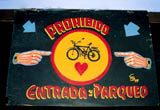Street art Cuban style
Barry Dawson’s photographic book Street Graphics Cuba captures images of a country that reflect its remarkable history. Suzel Pitty takes a look.

“The truth that there is such a vigorous Cuba is eloquent enough,” cited Che Guevara in 1960, perhaps foreseeing the power of the visual over the literal in the history of his country.
The past 50 years of Cuba’s complicated history are well illustrated by its street graphics. Fading remnants of pre-revolution tourism, alongside the dominant propaganda of Castro’s anti-capitalism, are now dotted with traces of the burgeoning consumerism that has come with the return of tourism. Cuba has become a top travel destination with all the accompanying interest in its cultural heritage.
In his new book, Street Graphics Cuba, photographer Barry Dawson has captured what he sees as a “defining moment in the country’s history”, as it undergoes the transition from an embargo-struck island to a free-market economy. This is the second book in his street graphics series which started with India, but his approach here is quite different. “I wanted [it] to be in an area new to both myself and the book’s ‘audience’, and Cuba fits the bill,” says Dawson.
Making his selection of imagery through “lateral approaches of enquiry, accident and luck”, he scoured the cities’ fleamarkets for photographs, postage stamps and banknotes. The result is a rich portrait of the street as an open gallery, providing a catalogue of visuals – 210 colour illustrations – with concise information on each historical context.
Dawson explores each influence separately. Cuba’s religions, where colonial Catholicism cohabits with the equally popular Santeria religion – “a blend of African Yoruba tribal beliefs and Catholicism” – throw up images of the crucifix and “an ever vigilant eye to ward off approaching evil”.
The cigar industry, Cuba’s greatest export, provides the requisite accessory to figurative images, and the high tail-fin and chrome trim of the American 1950s car that constitutes Cuba’s transport image, creates a peculiar marriage of symbols.
But for sheer volume of imagery, it is not so surprising that there are sections of the book dedicated to the Revolution and its figurehead Che Guevara. The style of street graphics may be changing, but the Alberto “Korda” Gutiérrez portrait of Che Guevara remains a constant source of inspiration. It is all the more interesting for its proliferation of uses – from steel and neon outline on the side of the Ministry of the Interior building, to the embroidered emblem on a thousand t-shirts.
Street Graphics Cuba recognises these colourful representations as free expression without the might of marketing. The visual language is fundamental in its approach, using primary colours of stylised hand painting or print.
With the possibility of the US trade embargo being lifted, Dawson may have captured the country on the brink of an inevitable US advertising invasion, which will have huge repercussions on Cuba’s visual imagery – think hoardings of Castro brandishing a Coca-Cola bottle.
Street Graphics Cuba by Barry Dawson is published by Thames & Hudson on 19 March, priced £12.95
-
Post a comment




